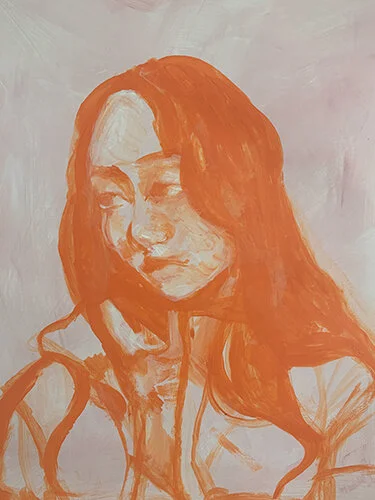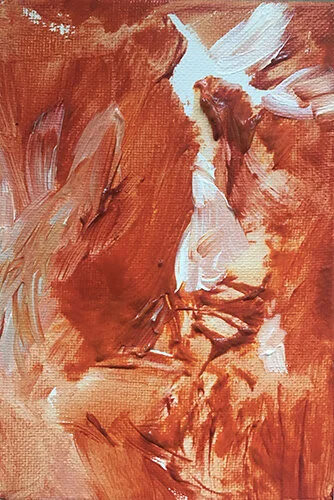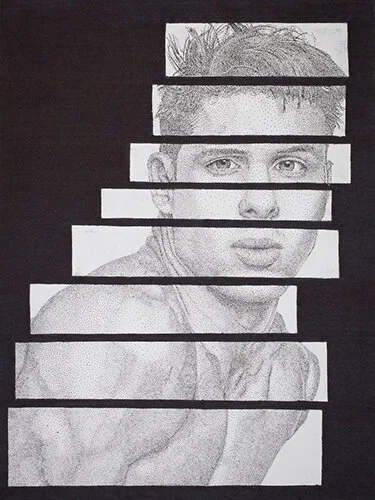
Journeys End - Life Beginning
A celebration of the amazing work of the senior drawing and painting students of Tam High School.
Charlie Abe
Julia Ciampa
Steviana Dunn
Joe Glynn
Elliot Gorham
Caroline Howell
Kathryn Kintz
Jaden Krietzman
Leland LeVassar
Lisa Adelson

LAra Akmehmet
Ever since I was little I’ve loved telling stories. I’ve always been moved by other people’s stories and inspired by my ability to create my own. But more than the stories themselves I find myself inspired by the people who tell them. And I think that’s why graphic novels and animation have always fascinated me in ways nothing els ever has. To many people the characters in comics and cartoons probably seem somewhat random but to me they’re anything but that. When I read my favorite comics or watch my favorite cartoons I see the hours put into delicately designing a character created specifically to tell the exact story the author wants them to. Since people are the soul of any good story I think the ability to invent those people gives us more power than many of us realize. Often if a character is designed well enough they don’t even have to speak for you to hear their story. And that's what I hope to achieve with my art someday. I want to eventually design characters that tell my stories better than I could even tell them myself.


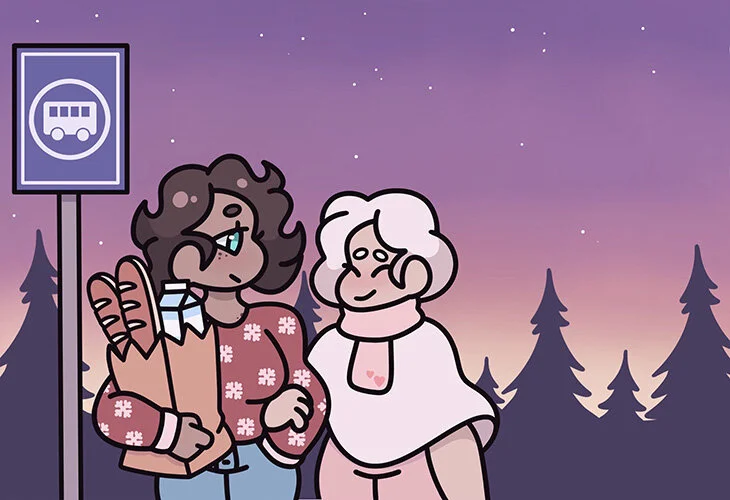

Bianca Arterberry
Drawing is just something I kind of do, y'know? But at the same time it's something that I'm passionate about and something that I hope to carry on throughout my life. Art is fun - frustrating, satisfying fun. Maybe sometimes more deep and personal, but even then the fun is still there. At the end of the day, that's all I really want to do when I draw: make something that I think looks cool while having fun with it.
Nikki Batroff
Just like most artists, I started before elementary school drawing rudimentary shapes and objects. Still, I continue to do that in the form of abstract art incorporating the human figure which fascinated me. My most common subjects are the people, in addition to chaotic and peaceful environments, respectively. I am described as having two main moods, which are reflected in her art. My soft mood encompasses painting people and plants from a delicate light, typically in watercolor. The opposite is described as harsh by the sporadic movements and rough acrylic strokes. Still, I feel at peace in both environments because they allow me to immerse myself completely without thought- that is what art means to me. Art is a way of expression for me and is essential to daily life.
Raffi Baumann
My work is a way for me to connect back to my home in Switzerland. All my pieces are of some place that I've been to and I remind me of my second home. My time in Visual Arts at Tam I has let me learn this new skill of block printing and has allowed me to find a new way to connect my work to something that is meaningful to me.
Katie Blackadar
Gracie Cameron
As a kid, I believe that I would have been classified as a “day dreamer.” I would spend my free time making up stories, writing skits, using books as an escape from reality, and imagining fairies, monsters, and other mythical creatures living in the forest behind my house. I have always valued the art of storytelling, and have carried it with me throughout my life. In my art I focus on this storytelling. Through illustrations, I create pieces that build worlds and develop characters, exploring the different subtleties and details that the character interacts with in their environment -- whether it be with the mundane found in everyday life or minute elements of a character’s personality. Specifically, I focus on the lives of two characters, June and Teddy, whom I have been drawing for the past four years. With there being so much darkness in the world, I want to bring in light to other people’s life by using my imagination, and the help of June and Teddy, to create “snapshots” of various windows into their world and evoke feelings of wonder, nostalgia, and comfort by emphasizing composition, using watercolor, acrylic, and sketchbook studies.
Mila Cheung
My sunflower pieces explore what it means to be human and who we idolize. When sunflowers can’t find the sun, they turn towards each other and I think that quality is also present in people. My realization series represents growth and personal awakening, something reflective of the last four years I have spent working on my art. The sunflowers in Mary, represent Mary and Jesus, because people look to them to lead them to salvation. The figure with the rose represents how humans can be brutal by hurting other people. The Sunflower 2020 series shows politicians, who we look towards to lead us and our country, but it’s also a commentary on how we make caricatures of them in the media.
At Tam, I’ve been encouraged to make art that is not only aesthetically pleasing but that also carries meaning. I find that I am always surrounded by people who want to see me grow and succeed and who push me to do so. Being in visual arts at Tam has let me experiment with materials and grow as an artist, as well as meet new people and make friends which I am forever grateful for. I will always miss joking around and making art with my friends in the corner of the art room.
Julia Ciampa
On the first day of freshman year when I received my schedule and noticed that I had been placed in drawing & painting instead of photography class I was very upset and disappointed. I tried to transfer but there was no space in photo so I went into drawing and painting with an open mind. There I was greeted by Mr. Gilmour and it quickly became my favorite class. Throughout these four years, Gilmour has helped me laugh, smile, get through the stress of school and life, give me support, give me a space to escape from the pressures of high school and provide a safe space to grow and never be alone. He has always provided me with materials to bring home so I can continue my art after school and he has helped me overcome artist blocks even though I’m not one to ask for much help. In the last four years of high school, my artistic passion and abilities have grown immensely. My techniques and imagination have grown and developed into skills which I have grown very proud of. My art gives me confidence, happiness and excitement. Next year I will be studying studio art at California State University, Chico. My decision to major in studio art is inspired by the sense of accomplishment, happiness, and enhanced creative thinking that making a piece of art gives me. When I feel stressed, art gives me a creative outlet where I can release my emotions and escape from the pressures of the real world. Throughout high school, creating art has increased my attention and helped me practice critical thinking skills. I can’t put into words how thankful I am to Mr. Gilmour for helping me find my passion and for supporting my journey as an artist. He has greatly motivated me to progress my art and he truly inspired me to take an artistic path in life. I will always be grateful for the impacts that Mr. Gilmour had on my life.




Rhys Colman
Ever since I was little, I haven’t been able to keep my hands still. From stamping our carpet with bright red ink, to creating paper ornaments for our Christmas Tree, I was always doing something. I have tried many different mediums, but in middle school I was introduced to a style of art I would grow to love, scratchboard. Scratchboard is “a way of creating an image by starting with a black surface and scratching through it to reveal a white layer below.” As I begin, I focus on the black sheet to conceptualize the image and then begin scratching with very light strokes. I divide the piece into sections, and methodically go through each one forming a cohesive visual to the final result. Throughout high school, I have tried out many different techniques, tools, and subjects. I mainly do pieces of animals and buildings, based off of photos I take or find online. I choose the photos based on what catches my eye, and I always look for something that makes it stand out amongst the others. I try to catch the personalities of each animal, or the details in each building. Even though each piece takes hours to complete, I lose myself in the process; and seeing what my hard work has created is one of the most satisfying feelings I know.
Elena Dworak
Art is my main form of self-expression, and it has become a key part of how I view myself. I now view the world in terms of what paint colors I would mix to capture that moment, and have trained my eye to see details or contrasts that weren’t apparent before. My art style has grown immensely since I began this program freshman year, and I have started to create art for my own joy and recreating memories rather than creating a perfect end result. My art mostly revolves around my love for nature, but also my curiosity about spirituality or admiration for classical Italian art. I wouldn’t have grown this much as an artist or expanded the limitations of my comfort zone without the supportive visual arts community of students and teachers at Tam.
Oliver Elm
Like many people, I consider art an opportunity to express something that cannot be put into words. The inherent mystique of a piece when it is put in front of you is a feeling that simply cannot be replicated. While observing art, you try to decipher its meaning, which can be interpreted in any number of ways. That is a feeling I try to provoke with my artwork. No matter how simple, art speaks. It’s a unique ability I consider invaluable.
My time taking art at Tam has not only provided a stellar environment for this feeling to take hold, but also encouraged me to have freedom and take risks with my work. Never before had I been able to walk into an art classroom and simply start creating a piece. As long as it was meaningful, it was valid classwork. Tam’s approach to art was the polar opposite of what had initially turned me away from art classes in the first place: The overly controlling environment was suffocating. However, with open access to countless materials and peers to offer insight and criticism, Tam allowed me to grow and explore just what I was capable of. It’s a system I applaud and hope to see more of in the future.
Megan Engelbrechten
Samantha Ferro
What qualifies as art? My generation seems to live during an odd episode in the history of art where the era of fine arts is giving way to a circumstance where most art is digitally created and viewed on the web. I have always been told and believed that art is a reflection of society, as the artist is informed by and offers a reaction to current events, trends, fashions, technologies, philosophies, and ideas. The art of today has become something more difficult to decipher as compared to the works of the great artists of the past, such as Degas, Van Gogh or Da Vinci, who I have been so fond of. What is one supposed to think when they come across a canvas, which sells for millions of dollars, that contains nothing more than a single white line running across a blue background? Such pieces seem to require almost no technical ability to the point that many will question whether they should be considered true art.
Twenty-first-century life is dominated by the use of computer technology, and as a result, artistic techniques and styles are more and more being influenced by and revolving around digital medium. One might say it is the age of digital art, which is significant not only because of the revolutionary and constantly changing way in which the art is produced but also in how people interact with the art by viewing it on the various electronic screens that pervade our lives. An artist of the digital age is forever faced with the challenge of trying to keep up with the constant and rapid changes in both hardware and software. Programs are endlessly being updated and improved with new features that need to be learned and then applied to one’s work. New programs are incessantly being rolled out so that the choice is overwhelming and keeping up is nearly impossible.
I have always spent my free time drawing. When I was young, I used graphite pencils and acrylic pens on paper, working solely on my technique as I tried to make my drawings look as realistic as possible. Many years later, when I joined the school newspaper during my freshman year, I transitioned to drawing everything digitally. For three years, I served as the graphics editor, overseeing general layout, often designing the cover, and producing much of the imagery to complement the articles. Throughout this experience, virtually everything I learned about digital drawing, layout and, production was self-taught. When I switched to the digital medium and was creating graphics for the school paper, I realized that I needed to not only learn the multiple programs but also to find more meaning in my work. As my graphics supported the articles in the paper, there were very clear ideas and purpose that inspired my designs. I was excited about this new, more meaningful dimension to my artistic endeavors. After a few years of applying my passion and talents to the school paper, I am now driven to continue down an artistic path by the hope that, with one image or overreaching layout, my work can tell a story, impart a feeling, motivate, influence, and change people's perspectives for the better.
I am drawn to graphic design and the digital art because its ability to reach a wider range of people. Whether I develop graphics for a product, advertisement, or magazine, I want people to be inspired by what I have to offer and say. As we transition into a new era of digital art, I hope to take my appreciation for contemporary clean lines and vintage french posters to contribute something visually unique with a meaningful message.
Laura Findlay




Nicole Forestier
I started creating art as soon as I could hold a paintbrush in my hand and don’t remember a time in my life when art wasn’t a part of it. Growing up, I picked up anything I could find to create something, whether it be using crayons to color outside the lines in coloring books, or markers and colored pencils to create comic books of bugs having adventures. What I loved most about art is that I could use it to escape, and I could use it to visually tell a story. I don’t know when or how I started having a specific style, but people tell me that in a lineup of art, you can pretty much tell which is mine. I think what makes my art identifiable is the color scheme, the way I draw people, and how most of my pieces convey a story. Over the years I have practiced with a variety of different materials, and have not stuck to just one. As a result, my style is composed of what I call, “making a mess with whatever range of mediums are on hand.” Most of my pieces are made with colored pencils, markers, micron pens, watercolors, gouache paints, and sometimes acrylic paint, gold ink, collage, stamps, and glitter pens. I have experimented with all of these materials in our beloved Tam art room, where I have spent an uncountable number of hours in the past four years of my life. I am grateful for the innumerable memories I’ve made there; hiding from the outside world, drinking hot chocolate, making friends, and growing as both an artist and a person.
Hayley Kibrick
I began drawing in kindergarten, but having an older brother who has always been a talented artist, I thought there was no way I could ever follow that. But as time passed, and I reached 8th grade, I was constantly doodling on homework, tests, and post its. And when I got to 11th grade, I filled sketchbooks with drawings exploring different styles, eventually leading me to pointillism. And yes, it drives me crazy. One drawing can take me anywhere between 9 hours and 2+ months.
At Tam I discovered that what I love about stippling is that there are no lines; your brain has to make sense of nothing but mere points repeated over and over on a piece of paper. I also found that the repetition calms me and helps me with my social anxiety. I use pointillism as a vehicle to display the complexities of people along with their personalities which seems to be a subconscious theme in my art.
I tend to draw men because I find them more complex to illustrate and still make them look natural with their various angles, lack of curves, and somewhat straight lines. Not that there's anything wrong with that! I just find them harder to draw and I do enjoy a good challenge.
But all in all, I don’t really know why I draw what I draw, or what my art says. But I do know I never want to draw another beard in my life. I know I just said I enjoy a good challenge, but not that much of a challenge. Hair is fine, but facial hair? I’ll have to get back to you on that.
Sara Kubo
Growing up in a very artistic household, I loved coloring in the drawings my sister drew, doodling un-proportional dogs, and painting distorted flowers. Although looking back they were very trivial things, they reminded me of my love for being creative at a young age.
My growth at Tam these four years(though I didn't take art my Sophomore year) have really been all about exploring different mediums and techniques. It was always about pushing my boundaries and being unafraid of messing up. Though it was difficult to define my artwork because I avoided being consistent, I wanted my art to be something new each time not only surprising other people, but myself as well. I eventually became stuck wondering what my portfolio really meant to me, and it took me a long time, but I found that my art represented my want for freedom within my own artistic limits and to keep myself from staying in one place never being out of my comfort zone.
Tam also made me realize how much space I take up and how much I love large pieces(especially canvases). I am really grateful for the resources and opportunities that all the art teachers have given us. Mediums that I might've never tried, had they not been already present in the art room, allowed me to experience new things and grow as an artist. I especially loved whenever Gilmour brought in bread because it was good.
Silvio
Marcellino-Lister
Ilaria Montenecourt



Lauren Pyfer
I usually begin painting after finding a remnant of my past. Little sketches or photographs act as a catalyst; ideas start to flow, and scenes emerge that are much more descriptive than what I could preserve in writing. My paintings are a record of my life. Layer after layer, I use the canvas to develop my story and shape my past.
When I paint, I go through a process of remembering, not of the specific event or recreation of a photo, but what was there past the surface, what I sensed, heard, and believed. My pieces take what was captured at that moment and evolve into a story- the warmth of my mother's loving gaze or the cold wind that bit at my nose as I climbed mountains with my father- buried within each layer of paint. I take apart the image and try to understand the relationship between depth and color, reconfiguring it to become my own. Through painting, I have been able to reflect on moments that feel so far away.
Kyrie Rogers
Skye Schoenhoeft
Last year, I started doodling while studying for the ACT — things just took off from there. I joined the art program this year as a senior having not taken art before (I was always a music kid). I started by sketching directly what I was seeing, but as I’ve worked more on my style, I now try to draw the feelings of what I’m seeing. I like to play with reality and draw a recognizable scene while adding the abstraction of emotions. My style ranges from very abstract, toying with warped self portraits and colorful backgrounds, to very basic ink sketches. I’m so thankful for all that I’ve learned in my short time with the Tam High Visual Arts Program and wish I could have had more time!

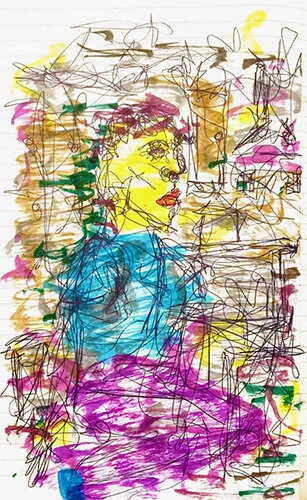


Ryan Talley


Phoenix Vogel
Julia Wong
Annie YE
Similar to other artists, I have been making art for as long as I can remember and I thought I can continue to do so for as long as I want, however, I have to stop working on pieces for a couple of years due to some personal reasons. I picked up the art tools again this year with the fear of not knowing what to do, but luckily, I was able to figure out my focus after two weeks of school. I have always been really into different traditional Chinese architectures from multiple time periods due to the details that they had and the feelings that they give, so I decided to recreate them by using construction paper and color pencils. It did not work as good as I thought at the beginning because of my poor time management and my fear of failing, but as time passed, I became more confident with the skills I learned from each piece. I am glad that I made the decision to do art again with those buildings using paper cutting and pencil drawing because it not only allowed me to explore more about my culture, but also made me to become more comfortable and detailed on works that I do.
































